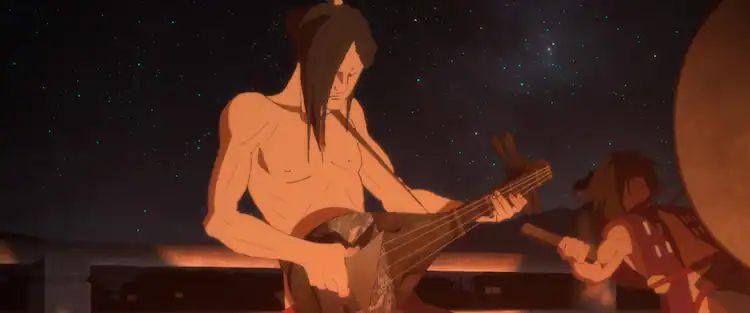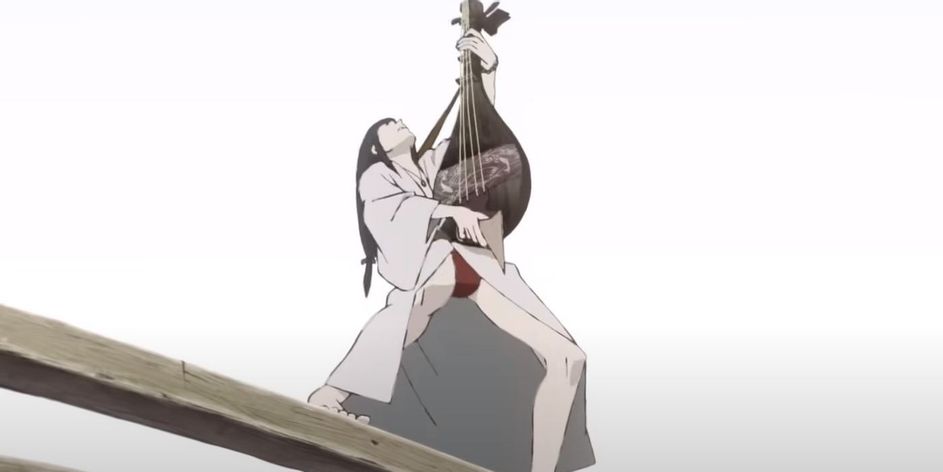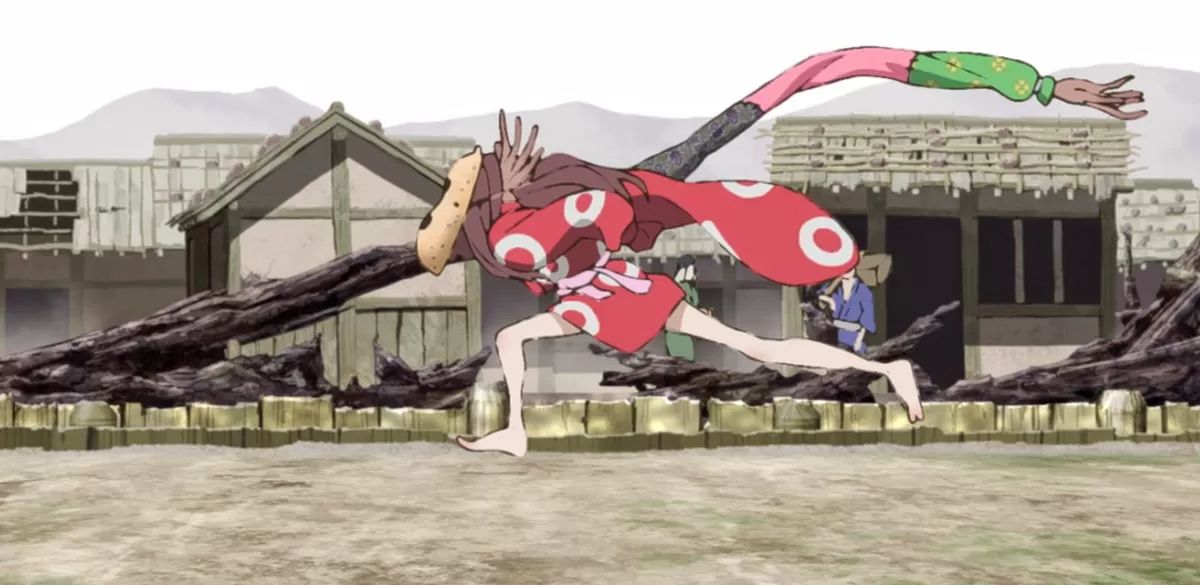Inu-Oh (2021)
It would appear that after producing some of my favourite anime in
recent years, Masaaki Yuasa's latest work Inu-Oh had a preview screening at the BFI in London courtesy of All the Anime. I
don't often go to the cinema but there is something quite powerful and
compelling about seeing a feature film in the cinema. Perhaps it is the
occasion or the communal viewing experience but as I took up my comfy seat
right in the middle of NFT 1, I was feeling very excited for what I was about
to watch.
It is the 14th century where priests and Noh performers share the stories of
a battle that happened 200 years previously between two rival samurai clans,
the Heike and the Genji. Their final battle took place in 1185 where at
Dan-no-ura the Heike were defeated (their story is commemorated in the Tale
of the Heike). In fact, it is an approved or endorsed history that these
priests and theatrical performers are sharing.
Into this world arrive Tomona and the self-named Inu-Oh. Tomona is a blind
travelling biwa player - a musician - who is blinded when he and his father
retrieve a cursed sword that the Ashikaga shogun desires for political
purposes. This sword was lost at the battle at Dan-no-ura. Inu-oh is the
disfigured and outcast child of a famous theatre performer whose face is
hidden behind a mask but who moves and dances with a vitality not displayed
by other performers. These two meet by chance on a bridge in Kyoto late one
night and become friends. Through their love and passion for their arts, they perform their tales of the Heike in a way that society has not seen
before. As performance, history, politics and the supernatural are smashed
together it is clear that things will never be the same again.
As I settled into my chair I was assaulted with sound and colour as the
story was set up. The opening narration did a great job of situating the
film in time and forewarning some of the elements to come and was told in a
grand and theatrical style by a masked performer. I did find some of this
sequence unsettling but I decided to go with it and see where we would end
up. This introduction coupled with a fantastic table-top like battle scene
at Dan-no-ura completely drew me in and reminded me of why I enjoy the visual
side of a Masaaki Yuasa directed production. He keeps the wonderful 2D style
that he favours but the camera moves as if it is in a 3D space, darting
between people or objects, plunging underwater and looking upwards or fixed
rigid like a member of a captive audience hanging off every word or action
of the performer.
The movement of the main characters also had that sense of freedom, setting
them apart from everyone else. Prior to being blinded Tomona leaps and
effortlessly navigates physical obstacles and later with biwa in hand takes
once again takes on that same sense of joy of freedom from constraints. Inu-oh
is the same. Although masked, ignored and outcast by a theatre performing
father they practice the movements the father teaches his other children off
to one side, just out of sight. They modify and extend the movements to
fit their body, gliding and moving to the music that is being played with a
sense of innocence and joy - it is clear that the family talent lies with
Inu-oh.
Art and performance is central to the story depicted in Inu-oh. Both of the main
characters are clearly looking for some way to express themselves and
finding each other gives them that spark to explore their respective and
joint art. And it is in these set pieces that the film really excels. As
friends, they clearly understand what the other wants but each have where
they are trying to get to in mind. The musical moments where Tomona plays on
the bridge are very much like rock concerts. They demand your attention with
their noise and the visual spectacle on display - be that the physical
exertions of the performers or the firebreather wowing the crowd. Tomona
clearly is lost in his performance and the audience loves it. At times he
reminded me of early rock and metal performers crossed with Ziggy Stardust.
As the physical performer Inu-oh was equally impactful and felt like a cross
between modern day musical theatre with spectacular visual effects and
ballet. In those performances, Inu-oh comes across as the best bits of a
cross between Freddie Mercury and Michael Jackson. Each performance by
Inu-oh has a custom stage to tell that one story where in one case lanterns
were used to create the effect of a whale travelling up the stage - we see
the work but the audience on screen sees an effect which looks like magic.
As the performance continues Inu-oh undergoes a transformation - is that
just a trick for the audience or is something supernatural at work? The
final production couples some amazing character animation where Inu-oh moves
like a ballet dancer with that fluid camera movement and it is utterly
fantastic.
An element I would like to have seen more of, but again it would have slowed
the film in some ways was how they visualised the world for Tomona early on.
What started out as a black screen was filled in as sounds are heard and
then, as a single sound becomes the focus the layers are stripped away to
reveal that one thing. The filling in was not fine detail however - crude
brushstrokes which over time have additional detail added to them but still
retained a degree of abstraction.
In between the set pieces, Tomona and Inu-oh explore that end state and we
start to see that artistic obsession creeps in, which begs the question of how
far they are willing to go to achieve their dreams. Just slightly out of
shot is the Ashikaga Shogun who watches with interest and schemes how he can
get what he wants from this new craze. An interesting exploration of how art
(and entertainment) can be and is used for political ends. This was another one
area I would have enjoyed having seen a bit more. It is entirely likely that
this is explored in more detail in the novel by
Hideo Furukawa the Tales of the Heike: INU-OH on which
this feature film is based. If it is available in English I will definitely
pick up a copy.
When the politics was explored on-screen characters would be introduced and
I started to recognise some of the names of the characters Nan'Ami. Had I
been watching this at home I would likely have been so frustrated that I
would have looked them up but the cinema forces you to just go with it (and I
really enjoyed that aspect). It was only during the final few scenes that I
remembered who they were (and where I had seen them so I could go and look
them up when I got home). Weaving in these real-life characters into the
story grounded it somewhat in the real world enabling it to switch from pure
fantasy to a myth or legend, and what artist or performer does not
want to be thought of in those terms?
One of the great things about seeing films at the BFI during their themed
seasons is that many of the screenings come with a couple of sides of notes
- I guess to mark the occasion and to give you something to read whilst
waiting for it to start. As I have stayed away from as much as I can about
Inu-oh I was surprised to see that this film was set to be his last film for a while whilst he is "…taking a break to study." (Variety, 7 September
2021) Thankfully Inu-oh is a great piece of animation and thoroughly
entertaining that he takes his break on a high note and was given a
spontaneous round of applause from the audience as the end credits rolled.
For fans of Yuasa, Inu-oh has the visual flourishes, aesthetic style, energy
and unpredictability that you come to expect from his works. For those new
to Yuasa, it is once again an accessible film much like his other recent
cinematic releases. It is visually very pleasing with the performance
elements bouncing between the exaggerated effort of the performers, camp
spectacle and almost magical fantasy. The way in which it shows how Tomona
"sees" the world is really pretty and I could have happily watched a film in
that style for 90 minutes. The movements of Tomona and Inu-Oh are superb and
at times I forgot that I was watching an animated sequence. Where this feels
different is in the music and the score. Whilst it was a main element of Lu Over the Wall in Inu-Oh it takes on greater significance almost becoming its
own character with its own development path and story. It is definitely
worth watching when it goes on wider release.
Inu-Oh was screened at the BFI Southbank and will be released theatrically by Anime Limited in the UK and GKIDS in the US sometime in 2022 (TBC).
★★★★☆
COMMUNITY RATING





























